The History of the Lotus in MTG | Black Lotus and More
MTG App Staff
12 Aug 2022
The Black Lotus has been one of the most iconic cards in all of Magic for almost 30 years. Wizards of the Coast has tried to mimic its power and beauty with varying degrees of success. But for most players, this classic card of yesterday always seems to be just out of reach.
Black Lotus: The Begining
Our story begins in August of 1993.
Magic: the Gathering took its first steps into the gaming world with an initial Alpha set that contained 295 black-bordered cards. Among them was the Black Lotus, an artifact that was free to cast and could be sacrificed to produce three mana of any one color.
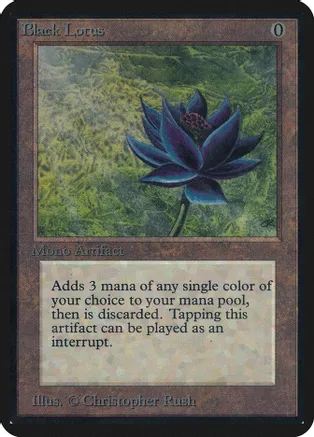
This is very powerful in a game where mana is your principal resource. Mana ramp dictates the speed at which a player can develop their strategy.
Being able to leap ahead by three steps, even temporarily, can offer a considerable advantage.
And in the game’s earliest days, there was no four-card limit to deck building like we have now. So you could put together 20 copies of black Lotus, 20 copies of Fireball, and 20 copies of Channel and win the game before your opponent could take their first turn.
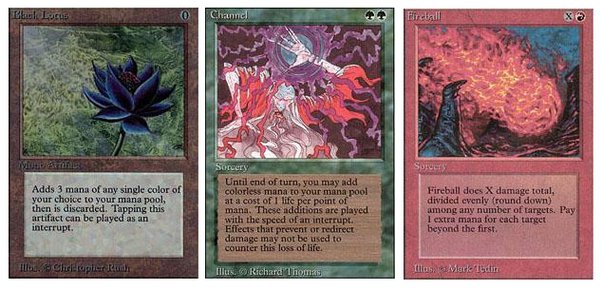
The raw power of the Lotus quickly placed it among the game’s most impactful cards, appropriately called the power nine, which included other fast mana sources, plus incredibly cheap extra turns and card draw.
However, the Lotus still stands above its eight cousins as something truly magical.
The concept of a supernatural flower can be found in ancient Greek and Roman mythology. Similar stories from earlier have probably been lost to the sands of time.
The original black Lotus is presently part of the reserved list which means it will never be printed again nor reproduced through a mechanically identical analog.
This restriction has forced the game designers to get creative in how they keep the memory of the Lotus and its power alive.
Attempts to Recreate the Magic of the Lotus
Lotus Vale
Their first attempt came in 1997 with Lotus Vale from Weatherlight.
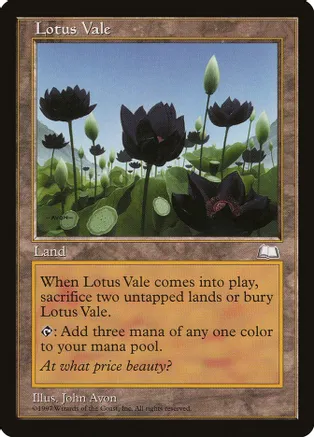
But Lotus Vale didn’t depict a singular flower with a particular use. Instead, this rare land card offered you the bounty of a whole field and a chance to tap into that power on every turn (provided you could afford the upfront cost).
Of course, the idea that the Lotus is an invasive species or requires tremendous effort to sustain somewhat explains why not every wizard or warlock has a garden of them to draw upon at their convenience.
Lotus Petal
The pendulum swung the other way for Tempest. Instead of a field of flowers, you could now hold a single Lotus Petal.
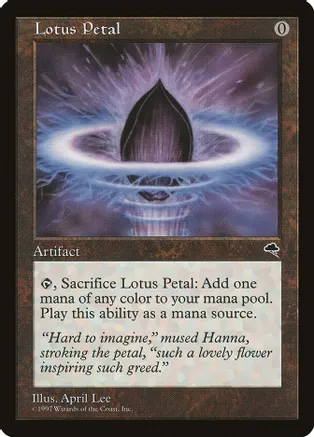
It provided just one mana of any color, but it was still free to cast.
That was still a powerful ability, so today, it is one of the top 20 most expensive commons to acquire in all of Magic.
Blacker Lotus
We don’t discuss silver-bordered cards very often in our history of MTG series. But for the Lotus, we’ll make an exception.
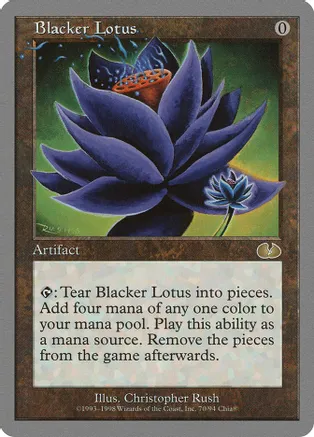
It’s fun to see how the iconic Black Lotus card has been represented in more tongue-in-cheek sets.
Blacker Lotus from Unglued was released in 1998. Artist Christopher Rush returned to create something that towered over his original Lotus. Not just visually but also in its ability to create mana. The casting cost was supersized this time: you had to physically destroy the card after using it. In my opinion, this took the joke a little too far, but it may be a wink at the increasing scarcity of the original Lotus.
Lotus Blossom
The following black-bordered interpretation came from Urza’s Saga with Lotus blossom.
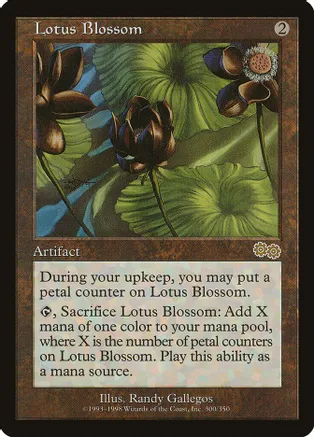
The Blossom was the first adaptation of the original Black Lotus with a non-zero mana cost (though it would not be the last).
To balance out the sizeable advantage of free mana, Lotus blossom required you to pay two mana upfront and then accrue petal counters during your upkeep. You could then sacrifice the card to create an amount of mana equal to the number of petals.
You had to weigh the right time to harvest your precious flower carefully.
Additionally, mana burn was in play during this time period. That added another layer of strategy. Letting the petal counters build without an end goal was a risk. You could end up doing real damage to yourself.
Lotus Guardian
Next came Lotus Guardian from Invasion. This was the first bulk rare to bear the word Lotus in the title.
Ouch.
Seven mana for a flying 4/4 is not great, even with the Birds of Paradise ability. I think the idea here was that by guarding a field of lotuses, the Guardian gained some of their mana-producing power.
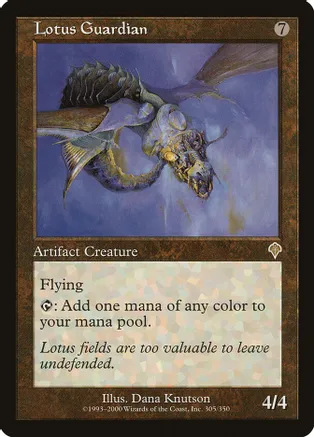
Overall, the card is weak and barely deserves to carry the word Lotus.
Unfortunately, it is the first in an era of underpowered Lotus cards.
Gilded Lotus
Gilded Lotus from Meridian Masques continues the trend. This card creates three manna like the original and can do it repeatedly without sacrificing itself like the veil.
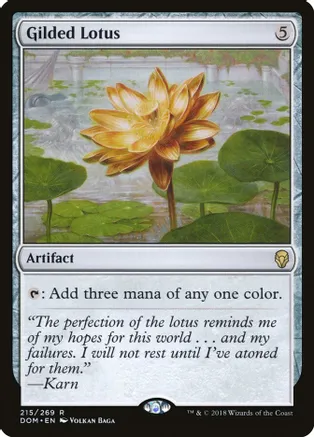
But it costs five manna to play. So it’s a steep investment cost.
Numerous reprints have made this Lotus one you can add to your collection for cheap.
Mox Lotus
Mox Lotus is the other silver-bordered Lotus card. This time, it combined the classic flower with the power nine jewelry.
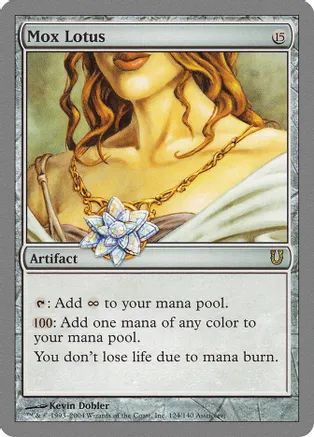
For 15 mana, you can create infinite mana while immune to mana burn. The mana burn benefit is not important today since that rule doesn’t exist anymore.
I think this card better captures the over-the-top power levels that both the black Lotus and the Moin are known for, especially compared to its unglued predecessor.
Lotus Bloom
Lotus bloom from time spiral gave you the true power of the original black Lotus, but it made you wait for three turns to access it.
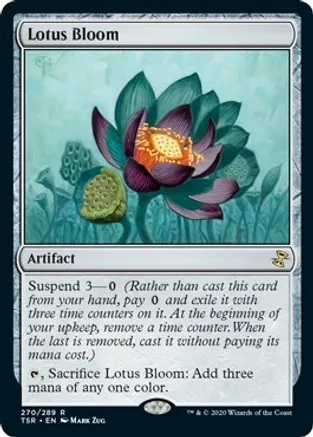
This made it play more like its sister Lotus Blossom. Still, in my opinion, this is the closest the game comes to repeating the OG card.
It is free to cast and creates three mana of any color upon sacrifice, with the only restriction being time.
Lotus Cobra
Zendikar saw the release of Lotus Cobra in 2009. This little snake has flavor text which boldly claims its scales contain the essence of thousands of Lotus blossoms.
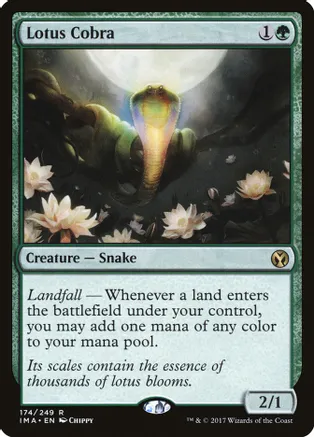
The landfall trigger is excellent, but it feels like you’re closer to a Lotus petal with legs (or scales) than anything else.
Lotus Cobra joins the Guardian in the club of Lotus creatures who do not possess the power of a Lotus.
That club also has a very depressing yearbook photo, and that’s because their membership grows in the Khans of Tarkir block.
Khans of Tarkir Lotus Cards
Lotus Path Djinn is a forgettable common with flying and prowess and some flavor text about Lotus flowers, blooming when mind and body become one, which is cute and all, but a waste of a great name.
The Khans one I’m frustrated with, though, is Lotus-eye Mystics. When they enter the battlefield, you can return an enchantment from your graveyard to your hand.
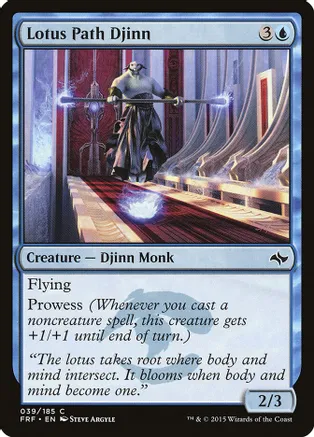
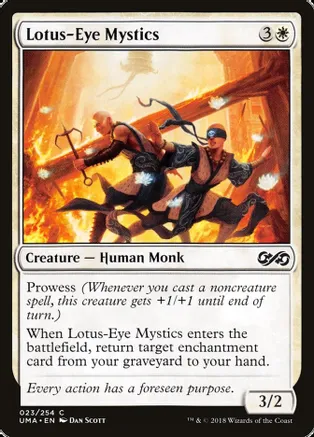
How many of the Lotus cards up to this point have been enchantments? Wait. I’ll tell you: It’s zero—a goose egg. Lotus cards are all artifacts, lands, or creatures.
I understand that the needs of the set dictated that this card could get back enchantments and only enchantments. But White seems to have similar cards that can bring back artifacts. So that would’ve at least made Lotus-eye Mystics relate to Black Lotus in a six-degrees-of-Kevin-Bacon sort of way.
Lotus Field
Lotus Field from M20, once again, put a Lotus in a core set. However, in this case, it’s a rare land rather than an artifact.
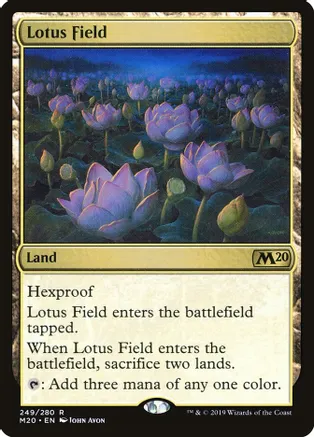
You can tell that Lotus Vale inspired the Field, but it differs in a few ways.
First, adding hex proof makes it much less likely that your opponent will punish you with a Field of Ruin after sacrificing two other lands to get this out. To offset this, it does enter the battlefield tapped, making you wait another turn to draw from its power.
Unless, of course, you happen to use it along with Blood Sun or Strict Proctor. Each offers a way to get around one of the Field’s downsides.
Mystery boosters gave us yet another way to experience the power of the Lotus so long as we were willing to share it.
Mirrored Lotus
They are a little confusing if you have not seen a card like this. These are mock playtest cards and are not legal for any constructed format. They don’t count as being silver bordered either.
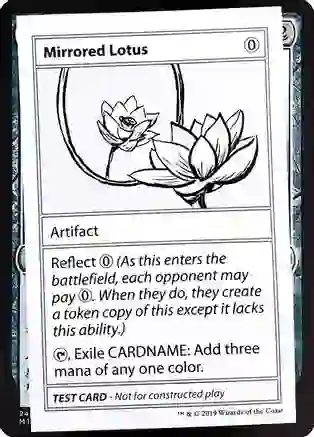
Mirrored Lotus provided a fun twist on the original design by giving each opponent their own copy through the reflect mechanic (I want to stress that reflect is not a real thing and might never come to the game in an actual set).
Nyx Lotus
While we wait to see if Reflect becomes a reality, we can play with a Nyx Lotus from Theros Beyond Death.
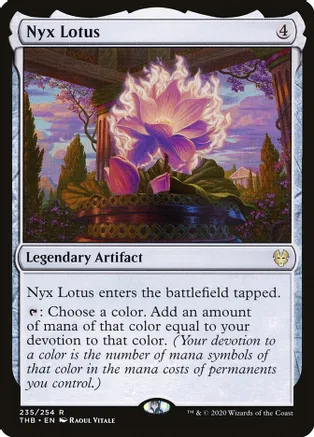
Nyx Lotus uses the devotion mechanic to determine how much mana it produces.
This seems harmless enough, but you could win the game on the spot with the proper supporting cards. This flower can provide an abundance of mana.
And now we come to perhaps the most interesting single card on the list.
Jeweled Lotus
Earlier I said that Lotus Bloom was the closest thing to an actual Black Lotus. However, many will argue that Jeweled Lotus from Commander Legends should take that spot.
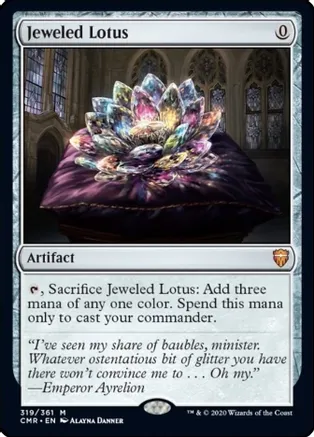
Like Black Lotus, this card costs zero mana and can be sacrificed to create three mana of any one color.
The restriction, for me, is the deciding factor. You can only use that mana to cast your commander.
Now, if this had created three mana of any color within your commander’s color identity, like Arcane Signet, it would’ve been useless still in non-commander formats, but it would’ve been closer to a true black Lotus.
Regardless, it’s still one of the most desirable cards from Commander Legends. And it certainly feels like a black Lotus in both form and function.
Wrapping Up
There’s one other honorable mention. I wanted to toss in here, and that’s Garth, One Eye from Modern Horizons 2.
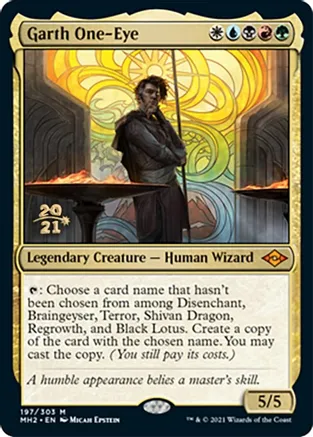
This legendary wizard can create a copy of the original Black Lotus, which neatly skirts around the reserve list while giving players a taste of the game’s most famous flower.
So what do you think? Has any card over the past 30 years come close to capturing the majesty of the original black Lotus? Let me know down in the comments.